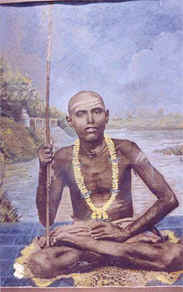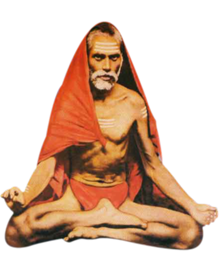A compact Biography of Shri Vasudevanand Saraswati Tembe Swami Maharaj
Renunciation: Wife's deathA short while after this, Buwa received divine orders to proceed to north. Defying all entreaties of the priests in Wadi, Buwa took leave of Mouni Swami and proceeded to Kolhapur, Pandharpur, Barshi and finally Gangakhed. At Gangakhed, his wife died of cholera on the 14th dark day of Vaishakh, 1891 AD. Buwa looked after her in her last illness and performed the last rites. Thus he was now completely free of all family bonds. Even as he was looking forward to be initiated to the monastic life, he had a premonition of his own death by cholera. He was so frustrated and angered that he started abusing the Lord. He blamed the Lord for not permitting him to take sanyas and now confronting him with an unclean death. By the Lord’s Grace, the death was averted and on 14th day after his wife’s death Buwa took the vows of asceticism. |
Vows of asceticismOn 14th day after his wife’s death Buwa took the vows of asceticism. The previous night the Lord appeared to him in a dream and initiated him to pranav mantra and ordered him to eat only madhukari food i.e. food solicited from three or more Brahmin households and not to accept monastery food. Next morning, Buwa went to the banks of Godavari, called learned Brahmins and performed the absolution rites (prayashchitta). Even as Buwa was wishing for, a sanyasi appeared from across the river and administered the vows of sanyas. Thus Shri Vasudev Shastri fulfilled his long cherished desire to become a sanyasi. It is notable that he entered the fourth ashram immediately after the termination of Grihasthashram (householder), following the injunction of the scriptures never to stay without ashram (AnaaEamaI na itYzot\). It would now be appropriate to refer to him as Paramhans Parivrajakacharya Shri Vasudevanand Saraswati Swami Maharaj. |
SceptreShri Swami Maharaj was ordered by the Lord to proceed to Ujjaini and receive the monastic sceptre from Shri Narayananand Saraswati. Accordingly he proceeded, on foot as he had always done, to Ujjaini via Washim, Umarkhed, Mahur, Khandwa, Badhawai, Onkareshwar, Mandaleshwar and Balwada. Staying in a Datta temple in Ujjaini, he went to Shri Narayananand Saraswati Swami Maharaj and solicited the sceptre. With the consent of his master Shri Achyutanand Saraswati Swami Maharaj, Shri Narayananand Saraswati Swami Maharaj ritually presented the sceptre to Shri Swamiji and bestowed upon him the Yogpatta (monastic name) of Shri Vasudevanand Saraswati. That day, on repeated entreaties of his Guru Swamiji partook the food at the monastery, thus violating the Lord’s orders. As a result, he started continuous vomiting which ceased only after Shri Narayananand Swami prayed Lord Dattatreya and asked for His forgiveness. Throughout Swamiji’s life, he had to strictly obey the Divine orders and any deviation invited punishment from the Lord. Swamiji spent his first Chaturmaas with his monastic guru at Ujjaini that year. Thus began the itinerancy of Swamiji. The purpose of his life was revealed to him by Lord Dattatreya when he ordered him to travel all over India and preach the Sanatan vedic path and bring back the people gone astray from Varnashram dharma. He traversed the country for the next 23 years following strictly the harsh discipline of the Sanyas Ashram. A brief chronology of major events in his life and an itinerary appears elsewhere |
possessionsHis possessions included 4 loincloths, 2 robes, the sceptre, a Kamandalu (wooden or bamboo water vessel), occasionally a woollen cloth, a book of Upanishads, a case of worship utensils, two idols of Datta and a cord to draw water and again occasionally some paper and writing materials. He had no other belongings. He washed his clothes and utensils himself and never accepted anyone’s service or anyone’s touch. If anybody touched him, he used to take a bath. Similarly, he used to take a bath every time he passed stools. He always travelled on feet and never used sandals. He used to walk fast. He avoided towns and cities and used to travel along riverbanks. He preferred to travel alone. He passed through dense forests, hot deserts and steep mountains, facing extremes of weather wearing only a robe. Only once, after a dip in the Ganges at her source, when he almost froze to unconsciousness, people warmed him with a fire to revive him. Otherwise he never permitted himself any exposure to fire in accordance with the Sanyasin’s code. He usually preferred to stay in some temple or other rather than homes. He was always on the move. He used to unhesitatingly set out on paths long abandoned due to development of railways and roads, often against the advise of the residents of the area. Sometimes Lord Dattatreya or other divine beings (viz. Ashwatthama) guided him. Only on a few exceptional occasions he stayed in one place for more than a week. As per the Sanyasin’s regulations he used to stay at one place only during the two months of rainy season. This period is known as Chaturmaas. Most of his 23 Chaturmaas were in small villages and remote places. Once people came to know of his Chaturmaas, they used to throng the place fighting great hardships and defying epidemics like cholera and plague. |
PersonSwami Maharaj was medium built, dark complexioned and not greatly impressive till he started speaking. His speech was soft but assertive, clear and incisive but warm and kind, detached and yet captivating, erudite and yet illuminating, concise but deeply influencing. He had flashy and piercing eyes, which appeared to look deeply into you. His austere lifestyle, deep and extensive knowledge of scriptures, his stringent adherence to religious code, his selfless approach and last but not the least his spontaneous, indiscriminate and innate compassion and genuine concern for all he met, won him the life long devotion of literally thousands of disciples, all across the country. In return he provided for them an ideal, a spiritual guide, a solace and succour, a symbol and an approach to the Divine. |
Daily scheduleShri Swami Maharaj woke up early about three hours before sunrise and after the morning ablutions, used to take his morning bath. He used to bathe at least thrice a day. After his bath, he used to worship the sceptre and perform the Pranav (Om) incantation and then offer ritual bath to the Datta idol and apply ashes to Him by way of worship. Indian monks are not permitted to pluck flowers and leaves (Tulasi, Bel) etc. Hence the idol got these offerings only when someone brought them for Swami Maharaj. The mornings were mostly devoted to teaching the students. Shri Swami Maharaj was a virtual living encyclopaedia of Vedic culture and used to teach seemingly unlimited range of subjects viz. Sanskrit grammar, Vedic texts, the technology of vedic rituals, the six systems of Indian philosophy (Yoga, Nyay {logic}, Sankhya, Mimamsa, Vedanta, Vaisheshik), Ayurveda (Indian Medicine) etc. His knowledge in these subjects was not merely theoretical but he was a Master who could guide a sincere student to the ultimate goal of all these Indian systems namely Self-realization. He was apparently well versed in several arts viz. music, poetry, spinning, weaving etc. He even advised right moves to chess players, sometimes without watching the game, though he never played himself. No sincere student was ever turned away by him. It was impossible to gauge the range and depth of his knowledge. Once at Narsobawadi, an old Brahmin, proud of his accomplishment in Samaved (the third of the Vedic quartet) came to Shri Maharaj and insisted on singing the Vedic Mantras, in spite of the latter’s suggestion to sing before the Padukas. Suddenly his memory failed and he could not recall even a single Mantra. Shri Maharaj then rendered a Mantra, convincing the Brahmin of Swamiji’s omniscience and deflating his pride. |
| At noon he used to set out to solicit food (Bhiksha). A Sanyasi cannot cook his food and hence has been ordained to solicit cooked food (Madhukari). Swami Maharaj used to accept food only from three to five homes of Southern Brahmins following the scriptural injunctions. There were periods in his life when travelling through certain parts of India, he did not encounter Southern Brahmins and had to live on coconuts, groundnuts and other ‘dry’ food. This often worsened his dysentery and caused much physical suffering. However this did not affect his schedule, pace, activity or the continuous journey. If anybody saluted on his way to Bhiksha, he used to fast that day. Sometimes such a fast used to follow the mandatory fasts of the 11th day (Ekadashi). On the day of fast he used to take a glass of buttermilk or a fruit. This did not seem to affect him in any way at all! He then used to dip the sack of collected food in river water and hang it so the water dripped out and with it all the taste! A Sanyasi, as indeed any seeker of truth, should eat only to support life and should be totally indifferent to taste. Swami Maharaj provided a shining illustration of this rule. The food was then offered to Lord Dattatreya, and split into three equal portions. After giving one portion each to the River and Gomata (cow) he partook the remaining one portion. He thus literally observed the rule of Sanyasi eating only eight morsels of food, that too only once a day. |
| In the afternoon, he used to entertain people. Some of them were genuine seekers knowledge and truth while a vast majority sought his advice for their personal problems. He gave all a patient hearing and offered solutions that satisfied everyone. After evening bath it was time for discourses on Puranas or scriptures. He had an excellent style of discourse, explaining the subject clearly with illustrations and authenticating his statements with apt quotations. Though he referred to Vedic mantras, he considered it a sacrilege to pronounce a Vedic sentence in discourse. Not only did he follow this canon himself but also insisted on adherence to it by others. There were occasions when he walked out of a discourse when the speaker uttered a Vedic Mantra. After the discourses, depending on the people around, there used to be Bhajans and Kirtans. After that, often there used to be some more individual interviews. It was well past midnight before Shri Swami Maharaj could lie down for a few hours of rest. How he managed with so little food or so little sleep is as beyond human comprehension. |

Download PDF version of compact bography

